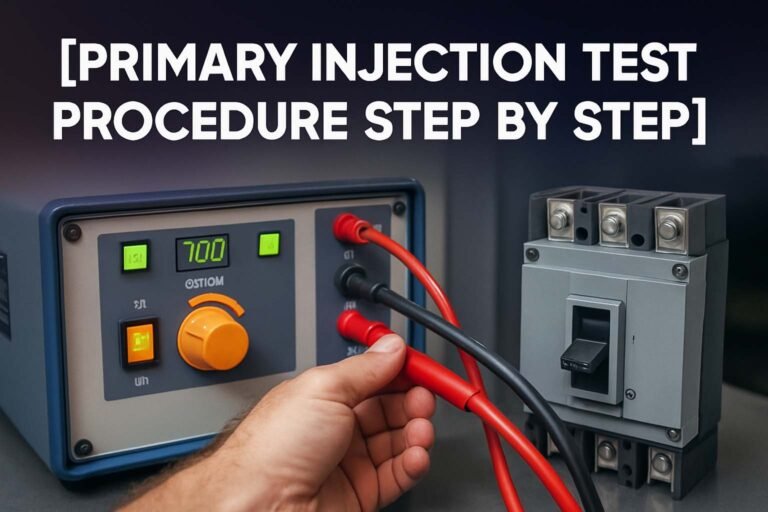How to Perform Dielectric Absorption Ratio Test? Benefits & Applications
The dielectric absorption ratio test is a key diagnostic tool used in assessing the insulation health of electrical equipment. This method is widely applied in industries where the reliability of motors, cables, and transformers is critical. In this guide, we will explore how to perform the dielectric absorption ratio test, understand its benefits, and examine its common applications. Whether you’re an electrical engineer, maintenance technician, or plant operator, understanding this test will add great value to your preventive maintenance strategy.

What is Dielectric Absorption Ratio Test?
The dielectric absorption ratio test, also called DAR, evaluates the quality of insulation material by measuring how it absorbs and resists an electric charge over time. This test helps detect moisture, contamination, and insulation aging.
When a voltage is applied to insulation, current flows. Initially, the current is high due to capacitive effects, but it should gradually reduce if the insulation is in good condition. This drop is tracked over time to form a ratio—called the dielectric absorption ratio.
This ratio compares insulation resistance at two different time intervals. Typically, readings are taken at 30 seconds and again at 60 seconds. If the insulation is healthy, the resistance should increase with time, resulting in a higher ratio.
Know more about Best Megger Insulation Tester 10kV
How to Perform Dielectric Absorption Ratio Test
1. Preparation for the Test
Before beginning the test, ensure the equipment is de-energized and properly isolated. Use lockout-tagout (LOTO) procedures for safety. Also, verify that the surface is dry and free from dust, oil, and moisture.
Ensure the megohmmeter or insulation resistance tester is properly calibrated and functioning. The most common test voltages range from 500V to 5000V depending on the equipment being tested.
2. Connect the Tester
Connect the test leads from the insulation resistance tester to the equipment. One lead goes to the conductor or winding, and the other goes to the ground or metallic enclosure.
Keep the connections stable during the test duration to avoid erroneous readings.
3. Apply the Test Voltage
Apply the specified DC test voltage to the insulation system. Immediately after applying the voltage, start the timer.
Take the first reading at 30 seconds. This gives the initial insulation resistance value.
Take the second reading at 60 seconds. This will be used to calculate the dielectric absorption ratio.
In some advanced versions of the test, readings may also be taken at 1, 5, and 10 minutes for extended analysis.
Know more about How to Use Megger Insulation Tester 5000V
4. Calculate the Dielectric Absorption Ratio
Use the following formula:
DAR = Insulation Resistance at 60 Seconds / Insulation Resistance at 30 Seconds
If the DAR value is higher than 1.25, the insulation is generally considered good. Lower values may indicate moisture ingress, contamination, or insulation degradation.
5. Record the Results
Document the values carefully. Note the environmental conditions like temperature and humidity, as they can affect the readings. Compare results with previous test records to evaluate insulation aging.
Technical Insight: Understanding the Current Components
The current in an insulation system during a DAR test includes three parts:
- Capacitive current – Flows immediately after applying voltage and dies out quickly
- Absorption current – Flows as the insulation absorbs charge; decreases slowly
- Leakage current – Represents steady-state loss; stays constant
A higher DAR indicates that the capacitive and absorption currents are decreasing while the leakage current is minimal, pointing to good insulation quality.
Table: Recommended DAR Values
| DAR Value | Condition of Insulation |
|---|---|
| < 1.0 | Poor – likely contaminated or wet |
| 1.0 – 1.25 | Marginal – aging or slight contamination |
| > 1.25 | Good – dry and solid insulation |
Know more about How Does a Megger Insulation Tester Work
Benefits of Dielectric Absorption Ratio Test
The dielectric absorption ratio test offers several benefits that make it a standard in insulation diagnostics:
Early Detection of Problems
The DAR test detects insulation deterioration before a complete breakdown occurs. It allows you to plan maintenance activities rather than reacting to failures.
Improves Equipment Reliability
By identifying insulation issues early, you can prevent unplanned shutdowns of motors, transformers, and cables. This leads to better system reliability.
Non-Destructive Testing
The test is non-invasive. It doesn’t damage the equipment and can be safely performed with minimal disruption.
Cost-Effective
DAR tests are relatively inexpensive to perform, especially when compared to the high cost of unexpected equipment failure or downtime.
Applicable to Multiple Assets
It can be performed on a wide range of equipment including motors, generators, transformers, switchgear, cables, and more.
Know more about IEC Standard for Protection Relays
Common Applications of Dielectric Absorption Ratio Test
Motors and Generators
The DAR test is often used during commissioning, routine inspections, or after a major overhaul of motors and generators. It helps detect moisture and contamination in windings.
Power Transformers
Transformers operate in harsh environments where insulation can degrade over time. Regular DAR testing ensures transformer windings are in good condition.
HV and LV Cables
The dielectric absorption ratio test is effective in identifying moisture ingress in underground or outdoor cables. This helps in preventing insulation breakdown and flashovers.
Switchgear and Busbars
In high-voltage switchgear, insulation tracking can lead to flashovers. DAR tests help ensure internal insulation systems are clean and dry.
Industrial Electrical Panels
Panels exposed to humid or dusty environments are tested regularly using DAR to ensure insulation strength is intact and prevent internal faults.
Know more about IEC 62368 1 Leakage Current
Why Use Dielectric Absorption Ratio Over Insulation Resistance Alone?
While insulation resistance tests give a single resistance reading, DAR gives a time-based perspective of insulation behavior. A high insulation resistance reading might look fine initially, but the DAR can reveal subtle insulation issues that static readings can miss.
For example, if both 30-second and 60-second readings are the same, the insulation is not improving over time, which can be a red flag. That’s why the DAR is a better predictor of long-term insulation performance.
Factors Affecting the DAR Test
Several factors can influence test results:
- Temperature: High temperature can lower resistance readings. Always try to perform tests at a standard temperature or apply correction factors.
- Humidity: Moist environments can reduce insulation resistance and DAR values.
- Contamination: Dust, oil, or salt can create leakage paths, reducing accuracy.
- Aging: Old insulation loses its ability to absorb charge, lowering DAR values.
Always consider these variables when interpreting the results.
Summary and Best Practices
Performing the dielectric absorption ratio test is a vital part of insulation diagnostics. It gives a better understanding of insulation health by measuring how it behaves over time under electrical stress.
Always ensure proper preparation before conducting the test. Use clean, dry surfaces and follow all safety procedures. Analyze both the DAR value and the insulation resistance readings for a complete picture.
Regular DAR testing adds value to your maintenance routine by preventing unexpected failures and prolonging the life of electrical equipment.
Follow Us on Social:
Subscribe our Newsletter on Electrical Insights for latest updates from Electrical Engineering Hub
#DielectricAbsorptionRatioTest, #ElectricalTesting, #InsulationResistance, #DARTest, #ElectricalEngineering, #TransformerTesting, #InsulationDiagnostics, #PreventiveMaintenance, #HighVoltageTesting, #PowerSystemProtection, #ElectricalSafety, #EngineeringTips, #DielectricTest, #ElectricalMeasurements, #TestingProcedures






